-
Content Count
101 -
Joined
-
Last visited
Content Type
Profiles
Forums
Gallery
Calendar
Articles
Store
Posts posted by storm boy
-
-
Cool' date=' I think I get it. So much the same as Snyderglass then ' they dont make them like that anymore ' type of scenario..[/quote']Mmmm got me thinking there. I have an original Snyderglass 5120 blank at home, still in it's wrapping, maybe I should build it up just to see what it's like.
 SB
SB -
-
Out of curiosity, how would they compare to a Snyder 5120, does anyone know?Cheers!SB
-
Here's a pic that shows how I use the sinker, I'm sure there are other ways too.This rig is called a pulley rig, it has a couple of functions:- it keeps the bait streamlined behind the sinker in flight, allowing a longer cast,- when a fish takes the hook, the sinker moves up the line, helping it to keep away from snags such as rocks etc.In the following pic, the main line is the one at the far right hand side, the rest of the rig is the pulley section.
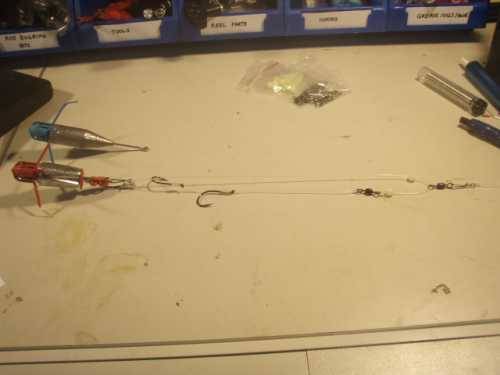 With this sinker, the hook is clipped under a little clip, and when the sinker hits the water, the plastic disc moves up and releases the hook.
With this sinker, the hook is clipped under a little clip, and when the sinker hits the water, the plastic disc moves up and releases the hook.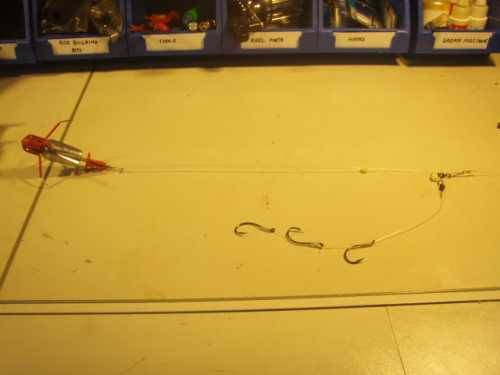 When a fish takes the hook, you can see how it pulls the "pulley" so that the sinker is up and out of the way.
When a fish takes the hook, you can see how it pulls the "pulley" so that the sinker is up and out of the way.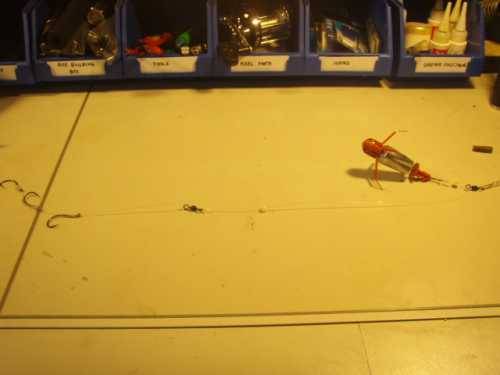 I mainly use this sinker for distance casting to structure off the beach, but also use a different clip in a similar rig for fishing over rocky areas for snapper. The following pic shows a Gemini Rig Clip used in a pulley rig, which also releases upon impact.
I mainly use this sinker for distance casting to structure off the beach, but also use a different clip in a similar rig for fishing over rocky areas for snapper. The following pic shows a Gemini Rig Clip used in a pulley rig, which also releases upon impact.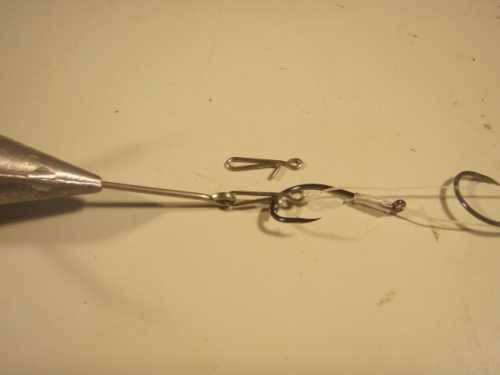 Finally, the proof's in the pudding
Finally, the proof's in the pudding  . Here's a nice little land based snapper taken with a pulley rig using the Gemini Splashdown sinker, from approx. 100-120 metres out.
. Here's a nice little land based snapper taken with a pulley rig using the Gemini Splashdown sinker, from approx. 100-120 metres out.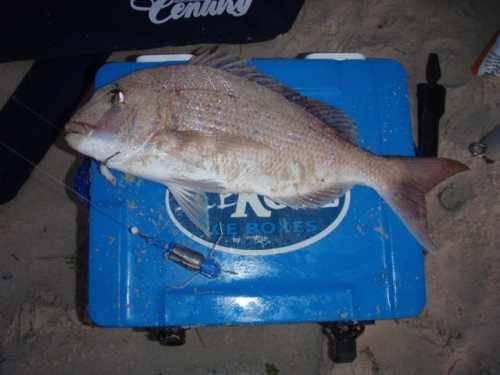 Cheers!SB
Cheers!SB -
-
Apparently it's hard to even lift with an 80lb game rod!
 SB
SB -
I'm into a bit of distance casting and thought I'd share a pic of a sinker that a mate put together as a bit of a joke. A couple of the other guys are distance casting with 8-10 oz and getting around the 170 metre mark (sinker only) over the field, so we thought they needed a bit of a challenge.If you look carefully you can see the weight written on the side of the sinker.I don't think this one would move in the surf but getting it out there could be a bit of a problem


 Cheers!SB
Cheers!SB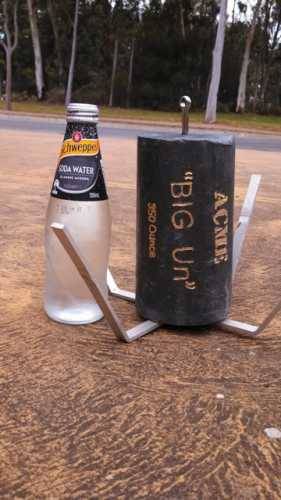
-
-
Hey Mr Balls! What would you know about mulloway fishing?


 What breaking strain line was the 50 pounder in your avatar caught on?Cheers!SB
What breaking strain line was the 50 pounder in your avatar caught on?Cheers!SB 
-
The other posts are pretty much spot on, 2-4 Kg or thereabouts is perfect for 95% of Coorong Mulloway. You could go heavier if you are only after the larger fish but the lighter rods and reels suit the majority of situations. Normally a 4-7 Kg snapper rod would be overkill.If I only had one combo for Coorong mulloway it would be a 2000/2500 sized reel, a 2-4 Kg bream rod matched to 6lb braid with a 12-20lb leader.Hope this helps!
 Regards,SB
Regards,SB -
Sorry mate, I thought the OP meant that the reviews had been removed.Regards,SB
-
It's still there, just not on the "recommended" or "not recommended" list.http://www.alanhawk.com/reviews/reviews.htmlCheers!SB
-
It's funny how the same manufacturer can have wildly different lines, but I guess they are marketed at a particular price point. For instance, Berkeley's Trilene Sensation is terrible, springs off the spool and knot strength is poor, but Berkely Big Game is pretty good. Same with the Sufix Duraflex (terrible) and the Sufix Tritanium (good), although the Duraflex is far more expensive than the Tritanium. Can't work that one out. :-)Regards,SB
-
It looks pretty basic with low resolution, but I guess you would expect it at the price point. If you were looking at these, I'd be inclined to spend $100 to $150 and get a far better name brand unit, as the cost of these is very reasonable nowadays.Hope this helps!Regards,SB
-
G'day Ausea,I did hear that Ultima had gone under but also heard a whisper there might be a buyer for the company or their product, will have to wait and see if anything happens, it's a shame.I just did a few knots with the Sufix Tritanium and it's a far cry from the Duraflex. I only tested the 12lb in clear, but initial impressions are good. I also have the 19lb (0.35mm) at home.The line tested at exactly the stated diameter of 0.30mm for the 12lb, slightly under the "standard" 12lb diameter which is 0.32mm.Bimini to bimini tested at 13-14lb with a steadily increasing pull, and somewhat surprisingly, a blood knot to blood knot gave the same result of 13-14lb.The line is slightly wiry but not excessively so, I'm keen to try out the Tritanium in the surf.
 The only downside is that I don't know of an Australian supplier. An upside is that from the UK it is very inexpensive - around $15-20 for a 1500 metre spool.
The only downside is that I don't know of an Australian supplier. An upside is that from the UK it is very inexpensive - around $15-20 for a 1500 metre spool. 
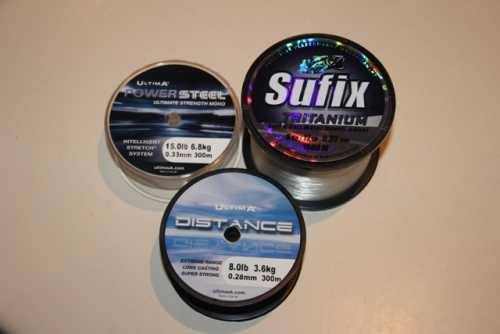 Cheers!SB
Cheers!SB -
The best handling, most supple mono I have come across is the UK made Ultima Distance. It is an extremely nice line to use, and while not the thinnest diameter for breaking strain around, it is quite reasonable, and the Ultima specs on diameter and breaking strain I have found to be accurate.I test all new lines that I get, and my favourite by far for general fishing is Ultima Power Steel. It is tough, nice to handle and breaks above it's rating when using Bimini twists.I tried out the Sufix Duraflex about 6 months ago and was very disappointed with it. The rated breaking strain was from memory 28lb with a stated diameter of 0.35mm, but when tested with biminis, would not exceed 16 lb. The Ultima Power Steel on the other hand in the 20lb rating was accurate with respect to measured diameter (I think it was 0.40mm) and I pulled it to 27+lb and it still didn't break.The actual strength of the Power Steel over the Duraflex was more than 20% stronger for it's actual cross sectional area.I was recently given some Sufix Tritanium which has a very good reputation, but have not yet had a chance to test it out.Hope this helps!Regards,SB
- urhookedfish and Just Me
-
 2
2
-
I also practice distance casting
 . While it's often true that the fish are at your feet, being able to cast that extra distance can open up a number of options that would otherwise not be available
. While it's often true that the fish are at your feet, being able to cast that extra distance can open up a number of options that would otherwise not be available 
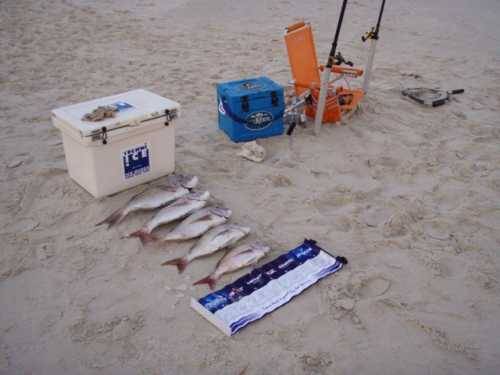 I've not used the Samaki Zing rods, but the major factor in distance is technique. Gear definitely helps, but correct technique is the key to distance. If you would like further information on distance casting, I can PM you some links.Cheers!SB
I've not used the Samaki Zing rods, but the major factor in distance is technique. Gear definitely helps, but correct technique is the key to distance. If you would like further information on distance casting, I can PM you some links.Cheers!SB -
Pulley rigs certainly work well.One situation where they are useful is when distance is required, or casting into a headwind as the rig is streamlined behind the sinker.The other place where they shine is in rocky areas. If you keep the hook trace quite short in relation to the sinker trace, the hook is kept above the rocks/reef. When a fish hooks up, the fish pulls on the hook trace, which then "pulleys" the sinker up to the top swivel, and hard up against the casting leader. This means that there is no longer a sinker dangling below the fish to catch on rocks or reef as it is pulled in.I use a type of sinker that has a hook release built in, that cannot accidentally unclip before the bait hits the water, although I also use the Gemini rig clips particularly when fishing rougher ground.Here is a link to a similar Gemini product that uses the locking clip systemhttp://www.fishermansheadquarters.com/tt_gemini-bait-clips.htmAnd here is another link:http://www.shoreangler.co.uk/Reviews/RigsAndBits/Gemini/Gemini-Splashdown.phpPulley rigs work a treat for most larger species including land based snapper
 Regards,SB
Regards,SB -
I'd have to agree with you. SFS is my go-to tackle store
 Regards,SB
Regards,SB -
I have used sliding baits, but not caught anything yet. It works off a "standard" surf beach, but you need the special one way clips and a quite a taut main line. Higher energy beaches work better, but if there is a strong sideways current it can make it awkward, as does weed. Fisherman's Paradise used to stock the clips, the weighted ones are better.Livies tend to swim themselves out, as they can only go in one direction, but dead baits can take a bit of "pumping" of the rod to get it out there.I know some keen shark fishos and they use it a lot, to get big baits out past the breakers where sharks tend to be. Sliding is a bit like long distance casting, it is common in other countries but in little ol' Australia we tend to stick to what we have always used, when there are other options and techniques out there.Cheers!SB
-
Another option which is popular in other countries is slide baiting, where a heavy grapnel sinker is cast out, allowed to bed into the sand, and then a one way bait "slide" clipped on to the main line with dead or live bait attached. The bait is then slides down the line with some help from wave action and pumping of the rod.This way, very large baits can be deployed long distances. Thicker mono lines of 20lb and above are used, and heavy/stiff actioned rods are preferable.http://www.alloutangling.co.za/Articles.asp?CategoryID=1&ID=10Hope this helps!Regards,SB
-
Another fan of the Decoy Jigging singles here. Most of my salmon metals have them.Regards,SB
-
I should just clarify my earlier post about accuracy with a baitcaster, it's only with the ultra light weight that there is an issue, up to maybe 3-4 grams. On the cast, the lure tends to "pull" in towards the rod as the spool is starting up, depending on the style of cast. This is particularly noticeable when casting sideways, but with heavier weights is not an issue at all.Cheers!SB
-
IMHO,Spinning reels reign when using very light weights such as bream lures. Baitcasters are not nearly so efficient at casting 3 grams, and can be less accurate.Low profile baitcasters are fantastic for heavier lures, maybe 6-8 grams and over. They are good for barra type fishing as lure placement in this weight range is easy and accurate, although spinning reels can also be used.Bottom bashing for whiting and snapper etc is a personal preference thing, both types work well.For surfcasting, both lures and long distances for bait, I much prefer overheads as I find them great to use and to tune, although threadlines work well too. Overheads off the beach are not for everyone, it really comes down to personal preference here too.Cheers!SB



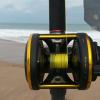
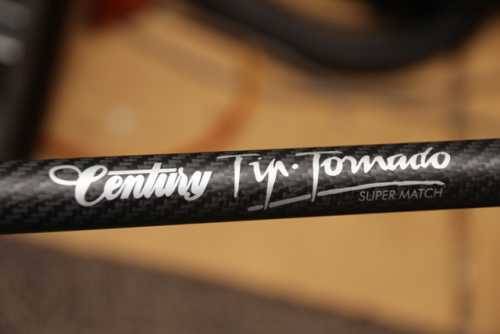
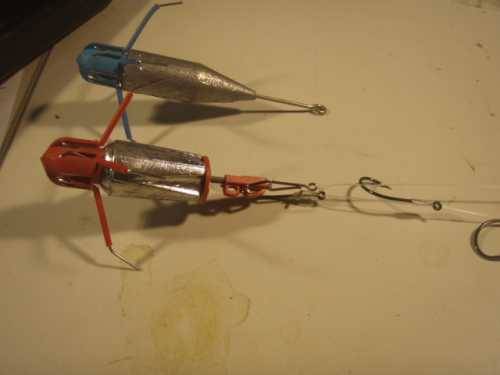
Rod extension
in Bait & Tackle
Posted
G'day DylbaaI'd say not, unless the rod came with multiple tips from the manufacturer, as some do.Regards,SB